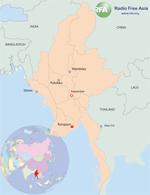



The market in Sittwe, the port city in far western Burma, was in a frenzy of buying and selling that morning when the monk approached.
“Where are you from?” he asked me.
“The United States,” I said.
“Ah, the United States…very powerful,” the monk said.
Then, without a moment’s hesitation, he launched into a diatribe against Burma’s military regime and its brutal crackdown against the so-called saffron revolution last September. At least 31 people were killed, many of them monks leading the pro-democracy marches in Rangoon.
“Bloody bastards,” he called the generals.
It was doubly shocking to me. First, that a monk, or any Burmese, would so publicly berate the government without at least looking over his shoulder to see if anyone was listening. Second, that a monk would use such strong language.
The bloodbath of September has created a tsunami of festering resentment among the monks and people of Burma. The monk in Sittwe was but one example. All over the country, ordinary Burmese were telling visitors how much they hate the government.
“This is an explosive situation,” said an acquaintance in Rangoon, the commercial capital. “No one knows what will happen next.”
The question on everyone’s mind is who will lead whatever does happen next.
The monks who led the nationwide protests in September have been killed, arrested, or forced into hiding in Burma or into exile in Thailand. Thousands of other monks who marched in the protests have been chased from their monasteries.
One of the leaders, Ashin Kovida. is now in Mae Sot, Thailand, after a harrowing escape from government agents hunting him down.
For six weeks after the protests, he hid in safe houses in Burma. Then, as his pursuers closed in, the 24-year-old monk bleached his newly grown hair, donned civilian clothes, got a fake ID card and, wearing a crucifix, escaped to Thailand.
“I have no regrets at having to leave,” he said. “I knew at the beginning what could happen. I’m just happy we were able to show the international community how bad this government is.”
The revolution will not end. It will happen again soon. The people are fed up.
Ashin Kovida, one of the leaders of the Saffron revolution.
Now, he said, a nucleus of 50 monks still inside Burma is organizing for another round, using the internet to make plans and to communicate with supporters outside Burma.
“The revolution will not end,” Kovida said. “It will happen again soon. The people are fed up.”
Fed up because the average Burmese worker earns the equivalent of $500 a year if he or she is lucky. And now, inflation is making it even harder to make ends meet. Poverty is rampant, especially in the countryside. Yet the generals at the top are raking in huge sums from the sale of the country’s vast offshore petroleum potential. China, India and Thailand are the buyers
The military dictatorship, in power since 1962, is showing no willingness to loosen its grip on this country of 47 million. Its paranoia has only increased since September. Monasteries and opposition groups are under surveillance. Anyone who speaks out risks arrest.
“There are eyes and ears everywhere,” said a friend in Rangoon.
All across Burma I saw red signboards with white lettering saying the government will ‘crush’ anyone who dares oppose it. For good measure, the signs are in both Burmese and English.
